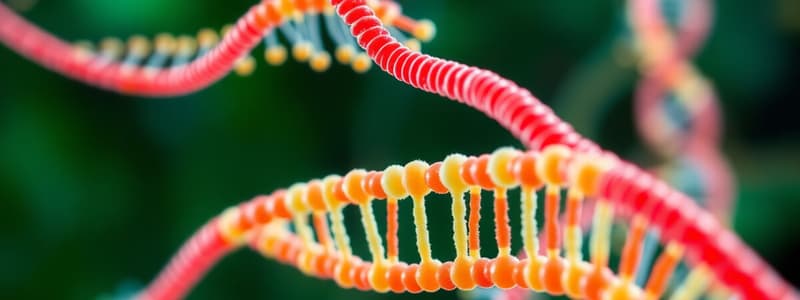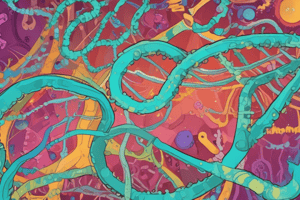Podcast
Questions and Answers
Which RNA polymerase is responsible for transcribing protein-encoding genes in eukaryotes?
Which RNA polymerase is responsible for transcribing protein-encoding genes in eukaryotes?
- RNA polymerase III
- RNA polymerase II (correct)
- RNA polymerase I
- RNA polymerase IV
How many RNA polymerases do eukaryotes possess?
How many RNA polymerases do eukaryotes possess?
- Two
- Four
- Three (correct)
- One
What type of genes does RNA polymerase I transcribe?
What type of genes does RNA polymerase I transcribe?
- 5S rRNA genes
- rRNA genes (correct)
- tRNA genes
- mRNA genes
Which of the following RNA polymerases is NOT found in prokaryotes?
Which of the following RNA polymerases is NOT found in prokaryotes?
Which function does RNA polymerase III perform?
Which function does RNA polymerase III perform?
What is the primary outcome of alternative splicing in RNA molecules?
What is the primary outcome of alternative splicing in RNA molecules?
Which statement best describes the role of alternative splicing in biological processes?
Which statement best describes the role of alternative splicing in biological processes?
How does alternative splicing contribute to diagnostics and therapeutics?
How does alternative splicing contribute to diagnostics and therapeutics?
What does the diagram of alternative splicing mainly illustrate?
What does the diagram of alternative splicing mainly illustrate?
In the context of alternative splicing, which describes its significance for organism development?
In the context of alternative splicing, which describes its significance for organism development?
What enzyme is primarily responsible for the synthesis of pre-mRNA during transcription?
What enzyme is primarily responsible for the synthesis of pre-mRNA during transcription?
During transcription, what is the relationship between the newly formed mRNA and the original DNA sequence?
During transcription, what is the relationship between the newly formed mRNA and the original DNA sequence?
What is the process called that modifies pre-mRNA into mature mRNA?
What is the process called that modifies pre-mRNA into mature mRNA?
In the context of gene expression, what role does mRNA play after its formation?
In the context of gene expression, what role does mRNA play after its formation?
What represents the primary outcome of the transcription process?
What represents the primary outcome of the transcription process?
What does the codon AUG specify in the process of translation?
What does the codon AUG specify in the process of translation?
Which of the following codons is considered a termination codon?
Which of the following codons is considered a termination codon?
How are codons structured in mRNA?
How are codons structured in mRNA?
What is the primary function of RNA polymerase during the elongation stage of transcription?
What is the primary function of RNA polymerase during the elongation stage of transcription?
In the codon table, what amino acid is encoded by the codon UUU?
In the codon table, what amino acid is encoded by the codon UUU?
What role does the genetic code play in translation?
What role does the genetic code play in translation?
Which base pairing occurs between the DNA template and the RNA during transcription?
Which base pairing occurs between the DNA template and the RNA during transcription?
In which step does RNA polymerase bind to the promoter region of the gene?
In which step does RNA polymerase bind to the promoter region of the gene?
What happens to the DNA double helix after transcription is complete?
What happens to the DNA double helix after transcription is complete?
What signals the termination of transcription in the presence of RNA polymerase?
What signals the termination of transcription in the presence of RNA polymerase?
What role do snRNPs play in the process of mRNA splicing?
What role do snRNPs play in the process of mRNA splicing?
What structural formation is created from the folding of the intron during splicing?
What structural formation is created from the folding of the intron during splicing?
What happens to the exons during mRNA splicing?
What happens to the exons during mRNA splicing?
What is released as a byproduct of the splicing process?
What is released as a byproduct of the splicing process?
After performing its function in splicing, what can snRNPs do?
After performing its function in splicing, what can snRNPs do?
What is the primary function of the 5' cap in pre-mRNA processing?
What is the primary function of the 5' cap in pre-mRNA processing?
Which of the following accurately describes the role of the 3' poly-A tail?
Which of the following accurately describes the role of the 3' poly-A tail?
During pre-mRNA splicing, what is primarily removed from the transcript?
During pre-mRNA splicing, what is primarily removed from the transcript?
How do end modifications affect the stability of mRNA?
How do end modifications affect the stability of mRNA?
What essential role does splicing play in pre-mRNA processing?
What essential role does splicing play in pre-mRNA processing?
What direction does transcription proceed in?
What direction does transcription proceed in?
In which direction is the antisense (template) strand read during transcription?
In which direction is the antisense (template) strand read during transcription?
Which of the following statements is true about the newly generated RNA strand?
Which of the following statements is true about the newly generated RNA strand?
Which end of the RNA strand is extended by RNA polymerase during transcription?
Which end of the RNA strand is extended by RNA polymerase during transcription?
Which of the following statements accurately describes the relationship between mRNA and the template strand?
Which of the following statements accurately describes the relationship between mRNA and the template strand?
Which type of RNA is primarily responsible for carrying information from DNA to ribosomes?
Which type of RNA is primarily responsible for carrying information from DNA to ribosomes?
What is the main role of transfer RNA (tRNA) in protein synthesis?
What is the main role of transfer RNA (tRNA) in protein synthesis?
Which statement accurately describes ribosomal RNA (rRNA)?
Which statement accurately describes ribosomal RNA (rRNA)?
Which of the following describes the structure of transfer RNA (tRNA)?
Which of the following describes the structure of transfer RNA (tRNA)?
What role does messenger RNA (mRNA) play in the process of protein synthesis?
What role does messenger RNA (mRNA) play in the process of protein synthesis?
Which of the following accurately describes a key difference between DNA and RNA?
Which of the following accurately describes a key difference between DNA and RNA?
Which nitrogenous base is unique to RNA as compared to DNA?
Which nitrogenous base is unique to RNA as compared to DNA?
What is the primary structural characteristic of RNA that distinguishes it from DNA?
What is the primary structural characteristic of RNA that distinguishes it from DNA?
Which statement best summarizes the functional relationship between DNA and RNA?
Which statement best summarizes the functional relationship between DNA and RNA?
How do the sugars of RNA and DNA differ structurally?
How do the sugars of RNA and DNA differ structurally?
Flashcards
Prokaryotic RNA Polymerase
Prokaryotic RNA Polymerase
In prokaryotic cells, there is only one type of RNA polymerase responsible for transcribing all types of RNA.
Eukaryotic RNA Polymerases
Eukaryotic RNA Polymerases
In eukaryotic cells, there are three distinct RNA polymerases, each with a specific role in transcription.
RNA Polymerase I
RNA Polymerase I
RNA polymerase I is responsible for transcribing ribosomal RNA (rRNA) genes, which are essential for protein synthesis.
RNA Polymerase II
RNA Polymerase II
Signup and view all the flashcards
RNA Polymerase III
RNA Polymerase III
Signup and view all the flashcards
Transcription
Transcription
Signup and view all the flashcards
Messenger RNA (mRNA)
Messenger RNA (mRNA)
Signup and view all the flashcards
Pre-mRNA
Pre-mRNA
Signup and view all the flashcards
RNA splicing
RNA splicing
Signup and view all the flashcards
Alternative splicing
Alternative splicing
Signup and view all the flashcards
Protein diversity
Protein diversity
Signup and view all the flashcards
Gene expression complexity
Gene expression complexity
Signup and view all the flashcards
Cellular differentiation and development
Cellular differentiation and development
Signup and view all the flashcards
Implications for diagnostics and therapeutics
Implications for diagnostics and therapeutics
Signup and view all the flashcards
What is a Codon?
What is a Codon?
Signup and view all the flashcards
What is the role of AUG?
What is the role of AUG?
Signup and view all the flashcards
What is the role of UAA, UAG, and UGA?
What is the role of UAA, UAG, and UGA?
Signup and view all the flashcards
What is translation?
What is translation?
Signup and view all the flashcards
What is a Codon Table?
What is a Codon Table?
Signup and view all the flashcards
What happens during initiation of transcription?
What happens during initiation of transcription?
Signup and view all the flashcards
What is the purpose of elongation during transcription?
What is the purpose of elongation during transcription?
Signup and view all the flashcards
What happens during termination of transcription?
What happens during termination of transcription?
Signup and view all the flashcards
What is the role of RNA polymerase in transcription?
What is the role of RNA polymerase in transcription?
Signup and view all the flashcards
How does RNA polymerase build the RNA molecule?
How does RNA polymerase build the RNA molecule?
Signup and view all the flashcards
What does mRNA do?
What does mRNA do?
Signup and view all the flashcards
What does tRNA do?
What does tRNA do?
Signup and view all the flashcards
What is rRNA's role in protein synthesis?
What is rRNA's role in protein synthesis?
Signup and view all the flashcards
How do the three types of RNA collaborate?
How do the three types of RNA collaborate?
Signup and view all the flashcards
How is mRNA represented?
How is mRNA represented?
Signup and view all the flashcards
5' cap
5' cap
Signup and view all the flashcards
3' poly-A tail
3' poly-A tail
Signup and view all the flashcards
Pre-mRNA splicing
Pre-mRNA splicing
Signup and view all the flashcards
End modifications
End modifications
Signup and view all the flashcards
What is the purpose of splicing?
What is the purpose of splicing?
Signup and view all the flashcards
What is a spliceosome?
What is a spliceosome?
Signup and view all the flashcards
What are snRNPs?
What are snRNPs?
Signup and view all the flashcards
What is a lariat?
What is a lariat?
Signup and view all the flashcards
What are introns?
What are introns?
Signup and view all the flashcards
What are exons?
What are exons?
Signup and view all the flashcards
Template strand
Template strand
Signup and view all the flashcards
Non-template strand
Non-template strand
Signup and view all the flashcards
Direction of Transcription
Direction of Transcription
Signup and view all the flashcards
RNA
RNA
Signup and view all the flashcards
Ribose vs Deoxyribose
Ribose vs Deoxyribose
Signup and view all the flashcards
DNA vs RNA: Strands
DNA vs RNA: Strands
Signup and view all the flashcards
Uracil vs Thymine
Uracil vs Thymine
Signup and view all the flashcards
RNA's Role
RNA's Role
Signup and view all the flashcards
Study Notes
RNA Polymerases: Eukaryotes vs. Prokaryotes
- Prokaryotes: only one RNA polymerase
- Eukaryotes: three RNA polymerases
- RNA polymerase I transcribes rRNA genes
- RNA polymerase II transcribes protein-encoding genes
- RNA polymerase III transcribes tRNA genes and 5S rRNA genes
Studying That Suits You
Use AI to generate personalized quizzes and flashcards to suit your learning preferences.




